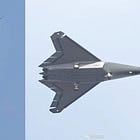Southeast Asia Faces Greatest Externalities Of Intensifying China-US Military-Technological Competition
🇨🇳 🇮🇩 🇵🇭 🇲🇾 🇸🇬 🇹🇭 🇻🇳 Extensions
This extensions-themed post is an extension of material that has appeared in another newsletter/section and other parts of my website more generally. While my newsletters/sections are primarily categorized by region, these can only appear in one newsletter/section, given how the Substack platform is configured, even as these may be highly relevant to readers who are primarily interested in other parts of the world.
In several recent posts that primarily appear in my China newsletter/section, I have discussed some of the externalities of the intensifying military-technological competition between China and the United States, a dynamic that is likely to leave many countries behind in the dust. With the partial exception of well-resourced Singapore, Southeast Asian countries have little to no immunity to the effects of this dynamic. As I explained in the context of the six new anti-ship munitions that were unveiled at the 3 September military parade in Beijing, most Southeast Asian countries are unable to keep up and deploy credible naval forces for the foreseeable future:
As things stand, Southeast Asian countries other than Singapore regularly cut corners in naval procurement in order to develop fleets that are more impressive on paper than in practice—and larger than fleets would otherwise exist if these countries procured more capable and more expensive warships with the same very limited budget. While Southeast Asian fleets were, of course, increasingly overshadowed by the PLAN over the course of the 2010s, their relative standing vis-a-vis China in 2025 and going forward is worse than it has ever been. Given the current and emerging threat environment, Southeast Asian countries are likely to be better off investing their limited resources in submarines, land-based anti-ship munitions, and maritime intelligence, surveillance, and reconnaissance (ISR) capabilities more generally, as well as terrestrial air defences. Contestations in the disputed waters of the South China Sea may require fairly large vessels, but do not require expensive vessels equipped with medium-end sensors and armament, not least when going head-to-head with the Chinese Coast Guard and Chinese maritime militia, which are backstopped by the PLAN and the rest of the PLA more generally.
Unveiling Of Six New Chinese Anti-Ship Munitions Highlights A Transformed Regional Naval Balance
The major military parade held in Beijing on 3 September 2025 served as an opportunity for China to unveil no fewer than six qualitatively distinct anti-ship munitions. While a significant development in and of itself and a significant development for the all-important China-United States military balance, the unveiling and presumed operational status o…
The externalities of intensifying military-technological competition can also be seen in other capability areas and other regions, above all in the critically important area of air combat capabilities. We are fast approaching a context in which Chinese combat aircraft will be able to essentially run amok, attacking targets in Southeast Asian countries—should these not remain neutral in time of war—with near impunity unless the United States deploys some of its immense but nevertheless finite military capabilities to defend the territory of Southeast Asian countries.
As I explained in two other recent posts, even Japan, a country that has access to considerable resources and a world-class technological base, is experiencing the negative effects of intensifying military-technological competition between China and the United States. A world in which even countries such as Japan are likely to struggle to counter the likes of China’s new anti-ship munitions and next-generation combat aircraft is a world in which Southeast Asian countries will be forced to fundamentally adjust how they allocate their finite, if in most cases steadily increasing, resources toward military capabilities in an increasingly precarious and increasingly high-stakes security environment. Whether Southeast Asian countries can make the necessary course corrections remains to be seen at a time when China’s options for undertaking long-range strikes against terrestrial targets are also fast expanding:






